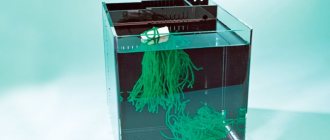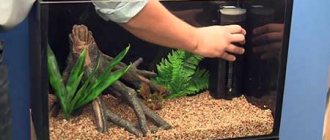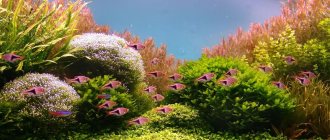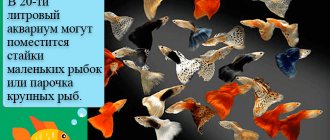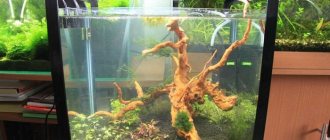An ordinary piece of driftwood in an aquarium can serve as a home and shelter for local inhabitants. This decor can be found in the store, or you can make it yourself. This is what we will talk about today.
An aquarium is not an ordinary jar into which you can throw various rubbish. This is a living corner where a fairy tale can come to life in the hands of an experienced and attentive aquarist.
Where to get driftwood for an aquarium?
Decoration, types of aquarium fish, equipment and plants - everything is in balance with each other.
The interior of an artificial pond depends on the imagination of the owner. Therefore, fashion trends that occur in human life smoothly flow into the underwater world. This also affects trends in materials used for decoration.
With the rapid change in preferences and fashion for decor, the time of the trend for plastic and artificial materials has quickly flown by. What can highlight the beauty of the nature of the underwater world, if not natural wood - driftwood for an aquarium. In addition, nature itself will give a unique shape to the driftwood. All that remains is to process it correctly and place it under water.
First you need to familiarize yourself with all the rules of working with wood. Otherwise, the fish may be poisoned or the water may rot. Next we will discuss the rules you need to know.
Pros of driftwood in an aquarium
- This is the final touch that completes the overall appearance of the reservoir.
- Bizarre curves provide fish with shelter and a place to play.
- The presence of natural wood softens the water.
- Some types of fish like to eat wood fibers, which is the prevention of certain diseases.
- You can grow moss on a piece of wood and plant plants.
- Properly processed driftwood releases tannins that are harmful to pathogenic bacteria.
- Additional shade of water.
What types of fish require snags?
In any case, the driftwood will transform the appearance of the aquarium. And it will be more interesting for the owner to watch the pets play. However, for some types of aquarium fish, wood in the water is vital. The fact is that they eat wood fibers. Otherwise, they will begin to develop diseases of the digestive tract. These are types of fish such as: catfish and panak.
Many fish begin to lay eggs in the roots of trees, in natural conditions. The same thing happens in an artificial reservoir. These are characin, glass and labyrinth perches.
Relatives of eels will also thank the owner for the peculiar labyrinths of branches and a new shelter.
When choosing wood, you need to be careful, as aggressive or overly active species can be injured by branches.
Ideal driftwood in an aquarium is wood without sharp corners, small in size, and without shoots.
Search for stones
The easiest way is to simply buy the required number of stones at a pet store. In this case, there is virtually no risk of getting an unsuitable or toxic breed. But since store-bought stones are pre-processed and prepared, their cost can hit your pocket hard . Therefore, many aquarists try to find pebbles on their own.
There are many options for where to get stones for an aquarium (for example, a stone yard, just on the street or in the forest), but you need to follow some rules. First of all, you need to know exactly which pebble is suitable for an aquarium and where you can find it. If the wrong stone is in the water, the result can be catastrophic, so several tests will have to be carried out before immersing it.
In this video you will learn more about aquarium stones:
How to choose the right driftwood?
Careful selection
An aquarist who respects his work will never in his life allow himself to stuff the first branch he comes across into the aquarium. Making the right choice is the basic rule that must be followed.
In order not to bother, you can purchase a piece of wood at a specialized store. This is the simplest option to decorate an aquarium. However, it is not the most budget-friendly. The main types of trees used are mopania and mangrove.
Such pieces of wood strongly color the water. Sometimes even to the point of brewing. On the way to its new home, the purchased driftwood collects microbes and viruses that can cause fish diseases. Therefore, upon arriving home, even purchased wood needs to be processed.
Before purchasing, it is better to read additional information, since some sellers do not disdain anything in order to make money.
That's why. Do-it-yourself driftwood for an aquarium is cheaper and more reliable.
What kind of wood is suitable?
You can use tree branches that have lain under water for a certain time, such as an apple tree, pear tree or willow driftwood.
Branches from spruce, pine or juniper cannot be used for a home aquarium.
The selected driftwood must be carefully checked for rot and rottenness.
A high-quality tree should be elastic and hard, without additional residents: insects and worms. Fresh branches will also not work.
So, the piece of wood has been found, now you need to cut off the moss and growths from it. You also need to clear it of bark.
Accommodation
How to lay stones on the bottom of an aquarium? It is recommended to follow the following placement rules:
- It is very important to position the largest stone correctly. Its structure should be clearly visible through the glass. This copy will form the center of the composition.
- Large stones should be placed on the left side. This way they will look less bulky. Small specimens are located on the right.
- If stones are placed in small groups, then all specimens should be approximately the same size.
- Massive specimens should not be placed close to glass. Otherwise, it may crack under the pressure of gravity. It is also not recommended to place stones in only one part of the tank. They should be evenly distributed over the entire surface of the bottom.
Aquarists often create large structures from stones. In this case, parts of the composition must be fastened with a special compound - aqua silicone. It is harmless to fish and provides high structural stability.
Preparation and processing
After the snag comes home, it needs to be processed - the bark must be completely removed. You should not regret the lost appearance of the tree, as the bark will begin to rot over time and bring harm to the inhabitants of the underwater world. In addition, fish can harm themselves by running into broken pieces.
Now the wood needs to be washed under running water and soaked in a saline solution for an hour. Salt is poured in until it stops dissolving. The wood will be boiled in this broth.
You need to boil the driftwood in an enamel vessel or stainless steel. “Cooking” time is 3-4 hours.
Here it’s better to be safe than sorry.
In addition, the thickness of the branch also affects the cooking time. There are times when the tree simply does not fit into the pan, so you have to turn it over. During the boiling process, you must remember to monitor the water level.
For that. To accurately destroy microbes, you can add potassium permanganate to the water.
After the piece of wood is prepared, it must be washed under running water and soaked in clean water for a week. This is necessary to remove the salt from the material, since the fish are freshwater. Among other things, the branch begins to absorb water, which makes it heavier over time. That is, it will not float up.
Some aquarists use a waste tank to rinse small pieces of wood.
Before placing the driftwood in water, you need to make sure that it does not float to the surface. Now you need to dry it and check how the wood behaves on the surface of the water. If the tree still floats, you will have to think about how to secure it to the bottom.
After installing the snags, it is better to start the ancistrus first. They will clear the branch of any remaining bark.
The color the water has turned will go away in 3-4 days. If the water is still of a different color, then you need to soak the wood again.
AQUADESIGN METHODS: DESIGN
The specific technique and artistry required to create a spectacular aquascape varies depending on what you are trying to achieve – the technique for creating a Malawi biotope is different from a paludarium – but all good aquascapes are the result of thoughtful design. Even if you have the artistic talent and knack to pick things up on the fly, spending a significant amount of time planning out all the details makes a huge difference in achieving the final result.
Realistic ambitions
In recent years, aquascaping has turned into a real art form, and truly real masterpieces have begun to appear in the world, which serve as a kind of reference point for many aquadesigners. However, to achieve a high level of mastery, you should always focus on your abilities in order to master certain subjects. Any aquarist can create a display, but unless you have the appropriate high-tech equipment or tools, the ability, or the patience to spend hours fiddling with individual plant strands, you're unlikely to create anything worthwhile. In aquatic design, you need to work as hard as you can, drawing inspiration and adding a spark of creativity - little by little, to create something that you can be proud of, even if you don’t win the competition.
Choose your style
Some of the best Iwagumi-style aquascapes strangely resemble rocky mountains, valleys, canyons, riverbeds and even waterfalls.
Whatever style you choose is your decision, but there are always limiting factors that can influence it. Free space, cost and availability of materials are what you will have to consider. If limited space or a tight budget only to buy a nano aquarium , a panoramic landscape scene is not what you need. If you can't purchase or install a CO₂ system or high-intensity lighting , then a carpet of fine-leaf plants is out of the question. But don't despair, there are many styles from which you can also draw your inspiration. Take, for example, an Asian biotope with plants similar to Cryptocoryne, which do not require bright light or CO₂. Here, to recreate a natural landscape, it is advisable to add some almond leaves or the Dark Water: Triple Effect conditioner from AZOO PLUS to allow the bog oak tannins to tint the water a little. To simulate the sun's rays, you can use cheap LED floodlights . Such an aquascape does not require large investments, but many fish feel great in it.
If your budget does not allow for expensive purchases, start thinking creatively: these Indian almond leaves can be used in an Asian biotope aquarium of a coastal river zone with low-maintenance plants.
Window shopping
Some people like to wander around local pet stores if they have one nearby. However, not all of them have a large selection of aquarium accessories. Recently, large online stores have appeared that have a wide range of aquarium products. Among these stores there are those that exist only at the expense of their goods, without collecting them “from the world by string” in order to fulfill this or that order. Such stores usually have their own showrooms. If you prefer to choose your own items from a variety of others and try out different combinations, visit a showroom to see all the different types of specialty stones and driftwood and talk to the salesperson. When creating an aquascape, try to visualize what exactly you need.
Thoughts on equipment
The picture of good aquascapes is sometimes spoiled by the presence of ugly filters or light heads that do not suit their style. Therefore, when planning and designing, you should take into account the design of the equipment you intend to use. Professional aquatic equipment dealers offer inlet and outlet glass tubing for external filters that can make piping systems as invisible as possible; the same goes for any CO₂ equipment. It is advisable to hide the heater behind the decor or use an external heater, filter or mud sump cleaning system if your budget allows. Thinking about the little things helps to avoid any difficult-to-adjust problems: for example, if your aquarium is installed on white foam and the white gaps on the glass bottom spoil the whole picture, replacing it with black will not be easy. If you're well off, you might consider using a clear glass aquarium: this low-iron type of glass is very expensive, but it's much clearer than regular glass and really enhances the picture. The difference between standard and cleared aquarium glass is comparable to the difference between regular and high definition television.
Marking your exhibit
Once you've decided on the style you're going to go with and have the necessary materials on hand, it's time to sketch out some of your ideas. Often the best aquascapes start with the simplest idea, or an object that makes up just a small part of the display. It may happen that you see a truly unusual piece of wood or buy natural driftwood for an aquarium, and you need to find the best way to frame it using secondary materials. The layout should also include your considerations for plants: make sure they fit the size of the aquarium and fit into the surrounding landscaping that defines the structure of the display.
Marking small architectural forms will allow you to easily reconsider various compositions. Notice how the branches seem to bend from left to right, as if they are being carried away by the current. (Photo by Chris Penny)
This is the same layout of stones and wood, but the Thai fern in the center is too large and hides the picturesque architectural features of the aquarium. (Photo by Chris Penny)



